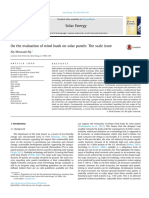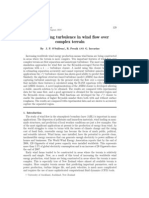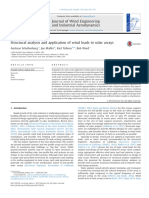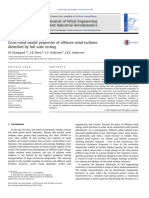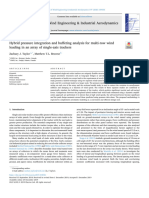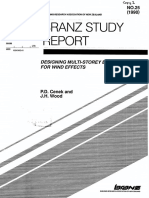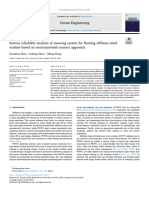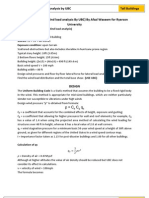Wind Loading Chain
Wind Loading Chain
Uploaded by
Ibrahim TarekCopyright:
Available Formats
Wind Loading Chain
Wind Loading Chain
Uploaded by
Ibrahim TarekOriginal Description:
Copyright
Available Formats
Share this document
Did you find this document useful?
Is this content inappropriate?
Copyright:
Available Formats
Wind Loading Chain
Wind Loading Chain
Uploaded by
Ibrahim TarekCopyright:
Available Formats
Announcement of the
Alan G. Davenport Wind
Loading Chain
Professor Alan Garnett Davenport (1932 2009)
On July 12, 2011 during ICWE-13 in Amsterdam, the General Assembly of the International
Association of Wind Engineering (IAWE) unanimously approved the use of the term the Alan G.
Davenport Wind Loading Chain for describing Alan Davenports approach for evaluating wind
loads and wind-induced responses for buildings and structures. Many of us remember Alan G.
Davenports name in connection with a number of specific technical aspects of wind engineering.
These include his power law wind profiles; his spectrum of turbulence; his admittance and joint
acceptance functions, which describe the spatial and temporal properties of turbulence as
required in the evaluation of dynamic wind action; his gust effect factor; his pioneering use of
wind tunnel model studies to chart the dynamic properties of buildings and structures; his
statistical methods for predicting maximum values of extreme winds and their effects of wind on
buildings and structures; and his criteria for judging the effects of wind on building occupants and
pedestrians. Notwithstanding his influence on these and many other specific aspects of wind
engineering, his greatest legacy is his rational approach or chain of thought, which ties together
these various concepts in the development of the methodology for evaluating the action of wind
particular buildings and structures.
Professor Davenports approach or chain of thought is described as follows:
Alans approach recognizes that the wind loading on a particular building or structure is
determined by the combined effects of the local wind climate, which must be described in
statistical terms; the local wind exposure, which is determined by the terrain roughness and
topography; the aerodynamic characteristics of the building shape; and the potential for load
increases due to possible wind-induced resonant vibrations. He also recognized that clear criteria
must be in place for judging the acceptability of the predicted loads and responses. These include
the effects of wind on the integrity of the structural system and the exterior envelope and various
serviceability considerations which influence performance and which determine habitability. The
latter include the wind-induced drift, the effects of wind-induced motion on occupants and the
usability of outdoor areas of the project, as well as its immediate surroundings.
In his papers Alan referred to this process for evaluating wind action as the wind loading chain.
This was in recognition that the evaluation of wind loading and its effects relies on several
interconnected considerations, each of which requires scrutiny and careful assessment. With
analogy to a physical chain, the weakest link or component of the process determines the final
outcome. Little is gained by embellishing strong links but much is lost by not paying attention to
the weak ones.
Alan and others have written about this wind loading chain and have used this chain concept to
describe and solve specific wind engineering problems. Perhaps the most lucid raison dtre for
this chain was articulated by Alan himself in his Chapter 12 of the book entitled Engineering
Meteorology, edited by Eric Plate and published by Elsevier Scientific Publishing Company in
1982. This chain or multiplicative process for arriving at wind loads has been adopted in many
building codes and standards. Not only is it effective for formulating the loads and responses to
wind action, it is also a powerful model for evaluating the reliability of the final outcome. For
example, the coefficient of variation of the predicted wind action to a good degree of
approximation is equal to the square root of the sums of the squares of the coefficients of
variation of each of the individual links. In the case of wind loads, the coefficient of variation (CV)
can be approximated as follows
CVwind load ( CV 2 reference wind pressure + CV 2 wind exp osure + CV 2 aerodynamic shape + CV 2 dynamic action )1 / 2
It is most fitting that the IAWE has decided to posthumously honor the late Alan G. Davenport by
adding the Alan G. Davenport Wind Loading Chain to the wind engineering terminology. This is
done in recognition of Alans many contributions to the development of wind engineering. It is
hoped that the usage of the term Alan G. Davenport Wind Loading Chain to describe the wind
loading process, as Alan developed it, will keep both the man and his work in our memory.
Nicholas Isyumov
Consulting Director
Boundary Layer Wind Tunnel Laboratory
The University of Western Ontario
London, Ontario, Canada
The proposal submitted to the IAWE to formally recognize the term Alan G. Davenport Wind
Loading Chain for use by the wind engineering community was supported by the following
colleagues at the BLWTL:
Horia Hangan, Director
Eric Ho, Director
Peter King, Director
Greg Kopp, Director
David Surry, Consulting Director
Barry Vickery, Consulting Director
You might also like
- Alan G Davenports Mark On Wind Engineering Isyumov2012Document13 pagesAlan G Davenports Mark On Wind Engineering Isyumov2012Raúl SánchezNo ratings yet
- (1998) Dynamic Wind EffectsDocument40 pages(1998) Dynamic Wind EffectsIbrahim TarekNo ratings yet
- Estimation of Extreme Wind Speeds: January 1995Document16 pagesEstimation of Extreme Wind Speeds: January 1995will bell100% (1)
- Green Sea ModellingDocument9 pagesGreen Sea ModellingJohn simpsonNo ratings yet
- Applsci 13 06389 v2Document21 pagesApplsci 13 06389 v2HassanNo ratings yet
- Experimental Aero NotesDocument62 pagesExperimental Aero Notesparveensaini100% (1)
- Fluctuating Wind and Wave Simulations and Its ApplDocument14 pagesFluctuating Wind and Wave Simulations and Its ApplClaudia Lemos RochaNo ratings yet
- On The Evaluation of Wind Loads On Solar Panels The Scale IssueDocument12 pagesOn The Evaluation of Wind Loads On Solar Panels The Scale IssueSara EidNo ratings yet
- Solar Energy 2016Document13 pagesSolar Energy 2016Manoj PradhanNo ratings yet
- Picozzi 2023 CALCDocument6 pagesPicozzi 2023 CALCVincenzo PicozziNo ratings yet
- Experimental and Theoretical Study of Wind Loads and Mechanical Performance Analysis of HeliostatsDocument10 pagesExperimental and Theoretical Study of Wind Loads and Mechanical Performance Analysis of HeliostatsrestyduranNo ratings yet
- 2 08 OsullivanDocument11 pages2 08 Osullivanmoro1381No ratings yet
- 2013 Structural Analysis and Application of Wind Loads To Solar ArraysDocument12 pages2013 Structural Analysis and Application of Wind Loads To Solar ArraysYanfei ZhuNo ratings yet
- Wind Design of Tall Buildings The StateDocument19 pagesWind Design of Tall Buildings The StateDinesh SilvaNo ratings yet
- A40-Driss Et Al. - SE - 2014Document8 pagesA40-Driss Et Al. - SE - 2014A-djouad MeriemNo ratings yet
- Was22060041 PublishedVersionDocument18 pagesWas22060041 PublishedVersionmusiomi2005No ratings yet
- PT LV WaveforceDocument9 pagesPT LV WaveforcehemantcabhaleNo ratings yet
- Simplified Strength Assessment For Preliminary Structural Design of Floating Offshore Wind Turbine Semi-Submersible PlatformDocument17 pagesSimplified Strength Assessment For Preliminary Structural Design of Floating Offshore Wind Turbine Semi-Submersible PlatformVũ Quý HoàNo ratings yet
- Review of Aeroelasticity For Wind Turbine Current Status, Research Focus and Future PerspectivesDocument16 pagesReview of Aeroelasticity For Wind Turbine Current Status, Research Focus and Future PerspectivesclaralisieNo ratings yet
- Modeling and Simulation of Transient Wind Load EffDocument11 pagesModeling and Simulation of Transient Wind Load Effforplayinggame120No ratings yet
- Hansen 2007Document20 pagesHansen 2007pravnvnNo ratings yet
- Ocean Engineering: Laszlo Arany, S. BhattacharyaDocument10 pagesOcean Engineering: Laszlo Arany, S. BhattacharyaLale ÖnerNo ratings yet
- An Assessment of The Usefulness of Water Tunnels For Aerodynamic InvestigationsDocument49 pagesAn Assessment of The Usefulness of Water Tunnels For Aerodynamic InvestigationsEddy WibowoNo ratings yet
- Fatigue Analysis of Offshore Wind TurbinDocument18 pagesFatigue Analysis of Offshore Wind TurbinDao Ba ThanhNo ratings yet
- Wind Loads On Low BuildingsDocument21 pagesWind Loads On Low BuildingsAb van AlfenNo ratings yet
- Aerodynamic Loads On Tall Buildings: Interactive DatabaseDocument11 pagesAerodynamic Loads On Tall Buildings: Interactive DatabaseHCStepNo ratings yet
- Risk Based Inspection Planning Optimisation of Offshore Wind TurbinesDocument10 pagesRisk Based Inspection Planning Optimisation of Offshore Wind TurbineseankiboNo ratings yet
- An_Extended_Assessment_of_Fluid_Flow_Models_for_thDocument31 pagesAn_Extended_Assessment_of_Fluid_Flow_Models_for_thMohammad NasreddineNo ratings yet
- Cross WindDocument15 pagesCross WindBilal MalikNo ratings yet
- Evaluation of Resistance Increase and Speed Loss of A Ship in Wind and WavesDocument7 pagesEvaluation of Resistance Increase and Speed Loss of A Ship in Wind and WavesCarlos HernándezNo ratings yet
- Journal of Wind Engineering and Industrial Aerodynamics: Namhun Lee, Hyungro Lee, Chung Baek, Seungsoo LeeDocument12 pagesJournal of Wind Engineering and Industrial Aerodynamics: Namhun Lee, Hyungro Lee, Chung Baek, Seungsoo LeeAlexandre AraujoNo ratings yet
- Dynamic Effects of Wind Loads On Offshore DecDocument23 pagesDynamic Effects of Wind Loads On Offshore DecRaj MeenaNo ratings yet
- 2020 Hybrid Pressure Integration and Buffeting Analysis For Multi-Row Wind Loading in An Array of Single-Axis TrackersDocument16 pages2020 Hybrid Pressure Integration and Buffeting Analysis For Multi-Row Wind Loading in An Array of Single-Axis TrackersYanfei ZhuNo ratings yet
- Software Simulation of Environmental Loads For Offshore Structures Primary DraftDocument12 pagesSoftware Simulation of Environmental Loads For Offshore Structures Primary DraftAhmed SabryNo ratings yet
- Preprints202007 0723 v1Document13 pagesPreprints202007 0723 v1Sahil JawaNo ratings yet
- Offshore Wind Turbine Environment, Loads, Simulation, and DesignDocument23 pagesOffshore Wind Turbine Environment, Loads, Simulation, and DesignJonathan ProcelNo ratings yet
- (Porté-Agel, 2011) - Large-Eddy Simulation of Atmospheric Boundary Layer Flow Through WindDocument15 pages(Porté-Agel, 2011) - Large-Eddy Simulation of Atmospheric Boundary Layer Flow Through WindDalmedson Freitas FilhoNo ratings yet
- Vortex-Induced Vibrations of Structures: Svend Ole HansenDocument1 pageVortex-Induced Vibrations of Structures: Svend Ole HansenalyaerNo ratings yet
- 1 s2.0 S0029801818314124 MainDocument14 pages1 s2.0 S0029801818314124 MainbillhanNo ratings yet
- 3D Engineering Model of Downburst Evolution in Thunde 2011 Procedia EngineerDocument10 pages3D Engineering Model of Downburst Evolution in Thunde 2011 Procedia EngineerEnsar OğuzNo ratings yet
- Engineering Structures: Ashraf El Damatty, Amal ElawadyDocument14 pagesEngineering Structures: Ashraf El Damatty, Amal ElawadyJosé Antonio Alarcón LeónNo ratings yet
- Vibrations of An Aramid Anchor Cable Subjected To Turbulent WindDocument18 pagesVibrations of An Aramid Anchor Cable Subjected To Turbulent WindSparrow JackNo ratings yet
- MASTR D 20 00175 - Revised - ShaofengWang2020Document28 pagesMASTR D 20 00175 - Revised - ShaofengWang2020王馨儀No ratings yet
- Directional Effect of Correlated Wind and Waes On The Dynamic Response of Longspan Sea Crossing BridgesDocument13 pagesDirectional Effect of Correlated Wind and Waes On The Dynamic Response of Longspan Sea Crossing BridgesAdi SutrisnoNo ratings yet
- Investigation of Flows Around A Rudimentary Landing Gear With Advanced Detached-Eddy-Simulation ApproachesDocument19 pagesInvestigation of Flows Around A Rudimentary Landing Gear With Advanced Detached-Eddy-Simulation ApproachesRafeyHabeebNo ratings yet
- Windloads On Offshore StructuresDocument16 pagesWindloads On Offshore StructureschbeggyNo ratings yet
- Integrated Load and Strength Analysis For Offshore Wind Turbines With Jacket StructuresDocument8 pagesIntegrated Load and Strength Analysis For Offshore Wind Turbines With Jacket StructuresChunhong ZhaoNo ratings yet
- WindDocument54 pagesWindjhoward2012npNo ratings yet
- SR 025 PDFDocument95 pagesSR 025 PDFPaulNo ratings yet
- Acta Astronautica: David A. Vallado, David FinklemanDocument25 pagesActa Astronautica: David A. Vallado, David FinklemanAmrullah Abdul QadirNo ratings yet
- 0 - Actions On Structures Wind Loads - CIB ReportDocument100 pages0 - Actions On Structures Wind Loads - CIB ReportWilliam PolNo ratings yet
- Advancement of Aerodynamics in Flutter Characteristics of AGARD 445.6 WingDocument6 pagesAdvancement of Aerodynamics in Flutter Characteristics of AGARD 445.6 WingIJRASETPublicationsNo ratings yet
- System Reliability Analysis Mooring System FOWTDocument17 pagesSystem Reliability Analysis Mooring System FOWTShadhin SudhershanNo ratings yet
- Archive of SIDDocument14 pagesArchive of SIDOSCARIEMNo ratings yet
- Wind 02 00026 v2Document16 pagesWind 02 00026 v2Ricardo MedeirosNo ratings yet
- Shir ZadehDocument11 pagesShir ZadehBilal MalikNo ratings yet
- Analysis of Wind Forces On A High-Rise Building by RANS-Based Turbulence Models Using Computational Fluid DynamicsDocument7 pagesAnalysis of Wind Forces On A High-Rise Building by RANS-Based Turbulence Models Using Computational Fluid DynamicsKamal DavuNo ratings yet
- E WiLES 2021 - BroucherDocument1 pageE WiLES 2021 - BroucherAshish HingnekarNo ratings yet
- Wind Load Analysis by UBC For Tall Buildings - Tall BuildingsDocument3 pagesWind Load Analysis by UBC For Tall Buildings - Tall BuildingsAfzal Waseem100% (1)
- Chapter 3 PDFDocument8 pagesChapter 3 PDFShazreel AmirNo ratings yet
- Concrete Mix Design ReportDocument20 pagesConcrete Mix Design Reportmehra.yogesh160No ratings yet
- Wind Loads For Petrochemical StructuresDocument265 pagesWind Loads For Petrochemical StructuresSyed Raziuddin100% (2)
- Performance-Based Design of Buildings Subjected To Wind LoadsDocument5 pagesPerformance-Based Design of Buildings Subjected To Wind LoadsdeviationzNo ratings yet
- Wind-Induced Fatigue Analysis of Wind Turbine SteeDocument10 pagesWind-Induced Fatigue Analysis of Wind Turbine SteeMarco FigueiredoNo ratings yet
- Infinity Tower, Dubai, UAEDocument10 pagesInfinity Tower, Dubai, UAEryan rakhmat setiadiNo ratings yet
- Section 207.1.2. Shall Be Not Less Than Specified in This SectionDocument8 pagesSection 207.1.2. Shall Be Not Less Than Specified in This SectionMarlo AristorenasNo ratings yet
- Technotes: The Advantages of Using Wind Tunnel TestingDocument4 pagesTechnotes: The Advantages of Using Wind Tunnel TestingWasim IlyasNo ratings yet
- Short Circular Steel StacksDocument12 pagesShort Circular Steel Stackskselvan_1No ratings yet
- ComparisonDocument168 pagesComparisonSathish KumarNo ratings yet
- Flow-Conditioning of The Wind Tunnel at Ryerson University To Model Boundary Layer FlowsDocument10 pagesFlow-Conditioning of The Wind Tunnel at Ryerson University To Model Boundary Layer FlowsHaitham AboshoshaNo ratings yet
- Draft Use or Cite: Chapter 31 Wind Tunnel ProcedureDocument6 pagesDraft Use or Cite: Chapter 31 Wind Tunnel ProceduresharethefilesNo ratings yet
- Investigating The Effect of Wind Load On MultiStorey BuildingsDocument5 pagesInvestigating The Effect of Wind Load On MultiStorey BuildingsEngr Manan AfridiNo ratings yet
- Analysis of Self-Supported Steel Chimney With The Effects of Geometrical ParametersDocument6 pagesAnalysis of Self-Supported Steel Chimney With The Effects of Geometrical Parametersvikram413No ratings yet
- Technical Specifications For The Installation of Telecoms Mast and TowersDocument138 pagesTechnical Specifications For The Installation of Telecoms Mast and Towerspremasiri karunarathne100% (1)
- WindDocument54 pagesWindjhoward2012npNo ratings yet
- Analysis of Communication Tower With Different HeiDocument20 pagesAnalysis of Communication Tower With Different HeiDesigns and Beyond BuildersNo ratings yet
- Behaviour of R.C.C. Tall Buildings Having Different Shapes Subjected To Wind LoadDocument5 pagesBehaviour of R.C.C. Tall Buildings Having Different Shapes Subjected To Wind LoadRiyaz SiddiqueNo ratings yet
- Presentation On Wind LoadDocument15 pagesPresentation On Wind Loadakash pandeyNo ratings yet
- Structural Behavior of A Guyed MastDocument17 pagesStructural Behavior of A Guyed MastcarsotNo ratings yet
- Comparison of Response of Building Against Wind Load As Per Wind Codes (IS 875 - (Part 3) - 1987) and (IS 875 - (Part 3) - 2015)Document1 pageComparison of Response of Building Against Wind Load As Per Wind Codes (IS 875 - (Part 3) - 1987) and (IS 875 - (Part 3) - 2015)KNo ratings yet
- Design and Construction of Skyscraper: Fig 1. Burj KhalifaDocument19 pagesDesign and Construction of Skyscraper: Fig 1. Burj Khalifaವಿನಯ್ ಎಮ್. ಆರ್100% (1)
- Lakhta Center Technical PaperDocument18 pagesLakhta Center Technical PaperWinston CkyNo ratings yet
- Wind Loads On High-Rise Buildings by Using Five Major International Wind Codes and StandardsDocument13 pagesWind Loads On High-Rise Buildings by Using Five Major International Wind Codes and StandardsboyNo ratings yet
- Windloads On Building CanopyDocument5 pagesWindloads On Building CanopyMaryNo ratings yet
- NEOM-NEN-TGD-304 - 01.00 - Wind Design Requirements For Building StructuresDocument11 pagesNEOM-NEN-TGD-304 - 01.00 - Wind Design Requirements For Building Structuresmahmudulalam konokNo ratings yet
- A Literature Study of Wind Analysis On High Rise BDocument4 pagesA Literature Study of Wind Analysis On High Rise BNILAY DEVNo ratings yet







